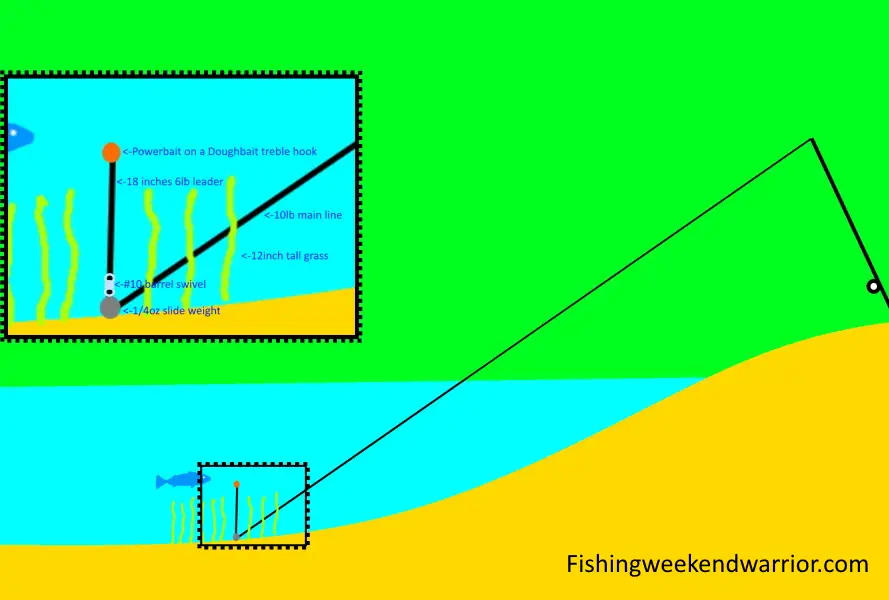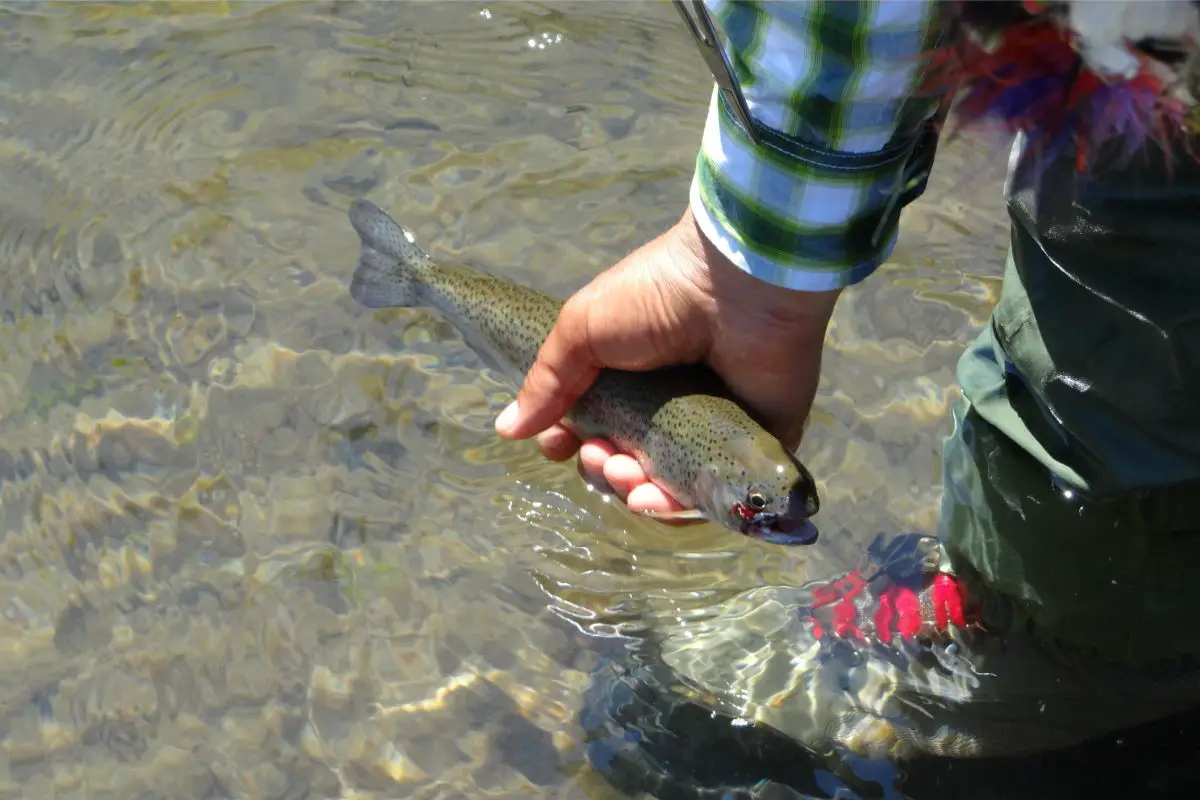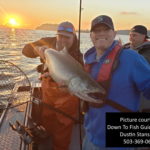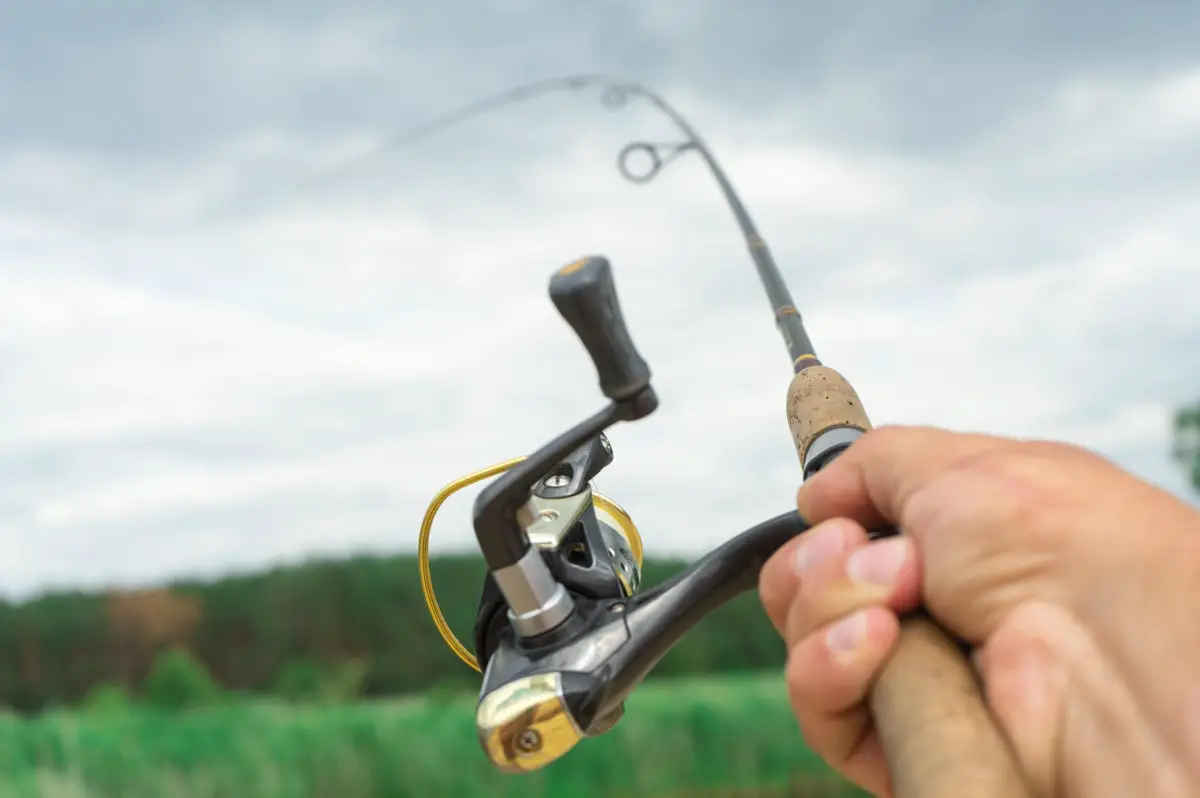Fishing for stocked rainbow trout is a popular sport; from spring through fall, fishermen of all ages pursue them. There are various ways to catch stocked rainbow trout, but using Powerbait is a proven technique.
A standard method for catching rainbow trout in a lake or a pond is Powerbait. A Powerbait rig is cast from shore. The weight rests on the bottom, and the bait floats up and targets passing rainbow trout. This method can be very effective when fishing for hatchery rainbow trout.
This article will tell you how to set up a Powerbait rig, explain the gear needed, and share tips for hooking into more rainbow trout.
Note: most links in this article are Amazon.com Affiliate links, see Affiliate Disclosure, thank you.
What Is Powerbait?
Powerbait is a dough bait created from oil-based resins and PVC. Placing small hand-rolled balls of Powerbait onto treble hooks is a deadly technique.
Rainbow trout eat small pellets until rainbow trout are released from fish hatcheries into lakes and ponds. Powerbait imitates these pellets and has added colors and scents to attract the rainbow trout.
Powerbait is designed to float and allows you to target specific parts of the water column. Rainbow trout cruise as they eat, and reaching different water depths are necessary.
Tip: Powerbait comes as a moldable paste in a jar. Seal the jar tightly as the Powerbait will dry out and become unusable if left open.

What Type of Powerbait Should I Use?
Berkeley Powerbait is the most popular brand and offers various colors and scents. Berklelys Natural Glitter Powerbait is an excellent choice and is easily visible to cruising trout.
These are viable options but creating small balls of Powerbait is always effective as it matches what the hatcheries feed the trout.
Tip: Berkeley creates different shapes of Powerbait, such as mice tails and eggs.
What Is a Good Rod and Reel for Rainbow Trout Fishing With Powerbait?
The Okuma Safina Spinning rod and reel are excellent for trout fishing with Powerbait. This setup is budget-friendly and has the sensitivity to detect even the lightest of bites.
The rod is a 6’0′ two-piece setup designed as an ultralight rod. The Okuma Safina Spinning rod offers sensitivity and durability, and the rod guides are created from stainless steel. The cork grip is lightweight and comfortable to hold while fishing.
The Okuma Safina Spinning reel is rated for 7lb max drag force, will hold 105 yards of 12lb monofilament line, and is made from machined aluminum, providing durability. This reel is tough, and its 1BB system provides further casting and smoother reeling.
We recommend loading this rod and reel combination with a 10-pound monofilament, so you have enough line in case your fish takes a run. If you want something stronger, go with a 20-pound braided line; your line will be the most substantial part of your setup.
What Is the Best Hook for Rainbow Trout Fishing With Powerbait?
There are various fishing hooks for trout but when using Powerbait, use a dough bait treble hook.
Treble hooks are necessary as they hold the Powerbait on the hook and provide better hook-up ratios. The South Bend Bronze Dough Bait Treble Hooks are an excellent choice as they provide durability, sharp hooks, and a tiny wire to keep the bait secure.
Treble hooks range from size 1-20, with one being the smallest. Use a size 12 treble hook as it is large enough to hook a trout securely but isn’t too heavy. Choosing a treble hook that is too heavy will sink your Powerbait and lower your chances of catching some trout.
Tip: Fishing with Powerbait makes catching and releasing trout difficult as they tend to swallow the bait. If you don’t plan to eat the trout, use alternative methods such as spinners with a barbless hook to release them.

How to Set Up for Rainbow Trout Fishing With Powerbait
Setting up a Powerbait rig is simple. Use 24 inches of 6lb monofilament line, a size ten-barrel swivel, a 1/4 ounce sliding weight, and your treble hook.
Begin by sliding the weight onto the main fishing line and tying on your swivel. Adding this section will allow the weight to freely slide up and down your line but stop at the swivel.
Once the weight and swivel are secure, cut about a 16″ -24″ piece of 6lb monofilament fishing line to use as a leader. Tie one end of the leader line to the swivel.
Attach your hook to the end of the line, and the Powerbait rig is ready.
Tip: Refrain from using split-shot (weights that clip onto the line) as the trout will feel its weight and let go. A sliding weight is a must for a Powerbait rig.
Does Leader Length Matter on a Powerbait Rig?
A leader is when you use a fishing line lighter than the mainline between your swivel and your hook. While 6lb monofilament is a versatile choice and allows the Powerbait to float, situations arise for a lighter line.
A few factors can determine the right leader length, like weeds in the water body and the trout’s location in the water collum.
If weeds or grass are at the bottom, cut a leader long enough to get above the weed line in view of the trout. The weeds will pull the Powerbait down if it isn’t long enough.
For example, if grasses are 12 inches tall on the lake bottom, you will add 6 inches to your leader for 18 inches total length. Your powerbait should float 4 to 6 inches above the grass, waiting for fish as they swim above the grass looking for a meal.
When placing your bait on a lake bed clear of vegetation, consider a short lead of 8 to 12 inches. Visibility should be better with less organic matter.
You might need to add to your leader length in deep water because rainbow trout will travel at different depths for different reasons throughout the day or season.
Adjusting your leader length can make the difference and allow you to find the trout faster.
Tip: If the water is extremely clear or shallow, consider using a 4lb leader line. A thinner leader line is more difficult for fish to see; however, keep your drag loose so the leader doesn’t break.
How to Catch Rainbow Trout in a Lake or Pond With Powerbait?
If you are new to a body of water, take a moment to examine the terrain before you cast out your Powerbait. Where you choose to cast your Powerbait depends upon water depth, current, and temperature when fishing for rainbow trout in a lake or a pond.
Fishing Powerbait for Rainbow Trout in a Lake
When fishing Powerbait from shore in a lake, don’t blindly cast. Look for dams, abrupt depth changes, and where water is flowing. Lakes don’t have currents like a river, so the trout seek oxygenated, cold water.
- Start by finding a steep bank close to the main boat ramp. Fish are likely stocked at the main ramp and remain in the area while acclimating to the lake. Cast your Powerbait rig in the steep location aiming for where the bank and lake bed meet, and wait for your fish.
- The next location to search is where creeks or cold water could enter the lake. Trout prefer colder water for many reasons, including more dissolved oxygen. Try casting your Powerbait rig where the lake bed starts closest to the creek. The cold water will flow from the creek along the bottom of the lake before equalizing out. Also, streams bring in food like bugs and small fish.
- Dams can be a great place to find fish. The outflow of water creates a current that rainbow trout will use to feed. When fishing, target the edges of the dam and cast your bait, so it doesn’t land on the dam structure. Dam areas can be very deep, so you try to position your power bait in 20 to 30 feet of water. Typically, I fish dams during the middle of the day when rainbow trout run deeper.
These tactics are just starting points for new lakes, but after you learn the lake, you will figure out where the best action is during different times of the day.
Fishing Powerbait for Trout in a Pond
Fishing ponds can be easier as the body of water is smaller. However, ponds present their own unique set of challenges.
- Most natural ponds have a stream or two flowing in and one stream flowing out. Start by casting your Powerbait rig where an inflowing stream’s fast water meets the pond’s slow water. Rainbow trout like to search this transition for food and prefer the cooler water.
- Cast to the deepest section of the pond, which is typically in the middle of the pond. Most ponds have a channel that runs from the inflow stream to the outflow stream. Google maps can help locate this channel as the satellite view only shows water deeper than five feet.
- Try fishing next to a structure in the water (a fallen tree) or by aquatic vegetation. Rainbow trout use structure for protection from the sun and predators. Also, fish like to feed in these areas throughout the day, because of bugs and smaller fish that live in these structures.
Ponds are a great place to fish when they are not crowded with many anglers. However, because of the shallow depth, most trout will not bite midday so bring a lunch.
Tips For Fishing With Powerbait in a Lake or a Pond
It always helps to have a few tips when you are a beginner fisherman. We have assembled some of our top trout fishing tips for lakes and ponds.
- Check online for updated stocking reports in your area. After they are released, trout will often remain for a few days. Finding and fishing where the truck stocks them is beneficial.
- The best times to fish for trout in a lake or pond are early morning and evening. Because rainbow trout don’t have eyelids, they tend to feed more in low light conditions.
- After casting out, watch the surface where you casted out for floating Powerbait. If your bait came off your hook during the cast, you should see it surface within a minute.
- Try to fish shaded areas as much as possible; keeping the sun to your back will increase the shade from trees or nearby mountains and hills.
- Reel in and recast to a different location every 20-30 minutes if there isn’t a bite.
- Once your bait has hit bottom, reel in all the slack, then release twelve inches of line. The slack allows a rainbow trout to eat and run with the Powerbait before feeling the tension from the line. Keep an eye on that rod tip!
- Avoid fishing close to the full moon cycle when the night sky is clear. Rainbow trout will feed at night if there is a full moon making daytime fishing very slow.
Final Thoughts
Fishing for rainbow trout with Powerbait in lakes or ponds is a simple yet tried and true technique. Rainbow trout fishing from shore can be exciting and cost-effective. Imitating the hatcheries’ food with Powerbait is vital to catching more rainbow trout.
Using this Powerbait rig, applying the tips, and learning trout habits will lead to you hooking up with more rainbow trout.





